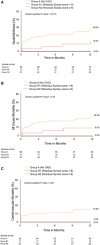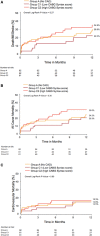Impact of Coronary Artery Disease Severity Assessed With the SYNTAX Score on Outcomes Following Transcatheter Aortic Valve Replacement
- PMID: 28219920
- PMCID: PMC5523783
- DOI: 10.1161/JAHA.116.005070
Impact of Coronary Artery Disease Severity Assessed With the SYNTAX Score on Outcomes Following Transcatheter Aortic Valve Replacement
Abstract
Background: The influence of coronary artery disease (CAD) on clinical and echocardiographic outcomes after transcatheter aortic valve replacement (TAVR) is still controversial. We sought to evaluate the impact of CAD severity as measured by the SYNTAX score (SS) on patients undergoing TAVR.
Methods and results: A total of 377 patients who underwent TAVR in 2 high-volume centers in North America were included in our retrospective analysis. A blinded angiographic core laboratory calculated the SS on all available coronary angiograms with the use of quantitative coronary analysis. Patients were stratified into 4 groups: (1) no CAD (SS=0); (2) low SS (SS between 1 and 22); (3) intermediate SS (SS between 23 and 32); and (4) high SS (SS ≥33). Patients who had undergone percutaneous coronary intervention within 6 months prior to TAVR were separated into 2 categories based on their residual SS (<8 and ≥8). Patients with previous coronary artery bypass grafting (CABG) were divided into 2 groups: (1) low CABG SS and (2) high CABG SS. The primary end point was a composite of all-cause mortality, myocardial infarction, and stroke. At 30 days and 1 year, both the presence and the severity of CAD had no impact on the rate of the combined primary end point and on all-cause mortality, cardiovascular mortality, and myocardial infarction. Patients with less complete revascularization (residual SS ≥8 versus residual SS <8 and low CABG SS versus high CABG SS, had similar rates of the combined primary end point, all-cause mortality, cardiovascular mortality, MI, and stroke, at both 30 days and 1 year.
Conclusions: In our core laboratory-validated study, neither the severity of CAD nor completeness of revascularization after percutaneous coronary intervention or CABG were associated with clinical outcomes after TAVR, at both 30 days and 1 year.
Keywords: SYNTAX score; aortic stenosis; coronary artery disease; transcatheter aortic valve replacement.
© 2017 The Authors. Published on behalf of the American Heart Association, Inc., by Wiley Blackwell.
Figures




Comment in
-
Clinical Conundrum of Coronary Artery Disease and Aortic Valve Stenosis.J Am Heart Assoc. 2017 Feb 20;6(2):e005593. doi: 10.1161/JAHA.117.005593. J Am Heart Assoc. 2017. PMID: 28219922 Free PMC article. No abstract available.
Similar articles
-
Coronary artery disease severity and aortic stenosis: clinical outcomes according to SYNTAX score in patients undergoing transcatheter aortic valve implantation.Eur Heart J. 2014 Oct 1;35(37):2530-40. doi: 10.1093/eurheartj/ehu074. Epub 2014 Mar 28. Eur Heart J. 2014. PMID: 24682843
-
Effect of coronary artery disease severity and revascularization completeness on 2-year clinical outcomes in patients undergoing transcatether aortic valve replacement.Coron Artery Dis. 2015 Nov;26(7):573-82. doi: 10.1097/MCA.0000000000000284. Coron Artery Dis. 2015. PMID: 26180996
-
Impact of extent of coronary artery disease and percutaneous revascularization assessed by the SYNTAX score on outcomes following transcatheter aortic valve replacement.BMC Cardiovasc Disord. 2021 Nov 30;21(1):568. doi: 10.1186/s12872-021-02374-y. BMC Cardiovasc Disord. 2021. PMID: 34847875 Free PMC article.
-
Impact of Coronary Artery Revascularization Completeness on Outcomes of Patients With Coronary Artery Disease Undergoing Transcatheter Aortic Valve Replacement: A Meta-Analysis of Studies Using the Residual SYNTAX Score (Synergy Between PCI With Taxus and Cardiac Surgery).Circ Cardiovasc Interv. 2018 Mar;11(3):e006000. doi: 10.1161/CIRCINTERVENTIONS.117.006000. Circ Cardiovasc Interv. 2018. PMID: 29870384
-
Aortic Stenosis With Coronary Artery Disease: SAVR or TAVR-When and How?Can J Cardiol. 2024 Feb;40(2):218-234. doi: 10.1016/j.cjca.2023.09.023. Epub 2023 Sep 26. Can J Cardiol. 2024. PMID: 37758014 Review.
Cited by
-
Transcatheter Aortic Valve Implantation With or Without Percutaneous Coronary Artery Revascularization Strategy: A Systematic Review and Meta-Analysis.J Am Heart Assoc. 2017 Jun 27;6(6):e005960. doi: 10.1161/JAHA.117.005960. J Am Heart Assoc. 2017. PMID: 28655733 Free PMC article.
-
Tpeak-Tend ECG Marker in Obesity and Cardiovascular Diseases: A Comprehensive Review.Scientifica (Cairo). 2024 Jun 26;2024:4904508. doi: 10.1155/2024/4904508. eCollection 2024. Scientifica (Cairo). 2024. PMID: 38962529 Free PMC article. Review.
-
Percutaneous Coronary Intervention in Transcatheter Aortic Valve Implantation Patients: Overview and Practical Management.Front Cardiovasc Med. 2021 May 4;8:653768. doi: 10.3389/fcvm.2021.653768. eCollection 2021. Front Cardiovasc Med. 2021. PMID: 34017866 Free PMC article. Review.
-
Clinical Conundrum of Coronary Artery Disease and Aortic Valve Stenosis.J Am Heart Assoc. 2017 Feb 20;6(2):e005593. doi: 10.1161/JAHA.117.005593. J Am Heart Assoc. 2017. PMID: 28219922 Free PMC article. No abstract available.
-
Progress in the Application of the Residual SYNTAX Score and Its Derived Scores.Rev Cardiovasc Med. 2024 Mar 1;25(3):80. doi: 10.31083/j.rcm2503080. eCollection 2024 Mar. Rev Cardiovasc Med. 2024. PMID: 39076942 Free PMC article. Review.
References
-
- Rapp AH, Hillis LD, Lange RA, Cigarroa JE. Prevalence of coronary artery disease in patients with aortic stenosis with and without angina pectoris. Am J Cardiol. 2001;87:1216–1217; A7. - PubMed
-
- Vandeplas A, Willems JL, Piessens J, De Geest H. Frequency of angina pectoris and coronary artery disease in severe isolated valvular aortic stenosis. Am J Cardiol. 1988;62:117–120. - PubMed
-
- Nishimura RA, Otto CM, Bonow RO, Carabello BA, Erwin JP, Guyton RA, O'Gara PT, Ruiz CE, Skubas NJ, Sorajja P, Sundt TM, Thomas JD; American College of Cardiology/American Heart Association Task Force on Practice Guidelines . 2014 AHA/ACC guideline for the management of patients with valvular heart disease: a report of the American College of Cardiology/American Heart Association Task Force on Practice Guidelines. J Am Coll Cardiol. 2014;63:e57–e185. - PubMed
-
- Stewart BF, Siscovick D, Lind BK, Gardin JM, Gottdiener JS, Smith VE, Kitzman DW, Otto CM. Clinical factors associated with calcific aortic valve disease. Cardiovascular Health Study. J Am Coll Cardiol. 1997;29:630–634. - PubMed
-
- Pibarot P, Dumesnil JG. Improving assessment of aortic stenosis. J Am Coll Cardiol. 2012;60:169–180. - PubMed
Publication types
MeSH terms
LinkOut - more resources
Full Text Sources
Other Literature Sources
Medical
Miscellaneous

